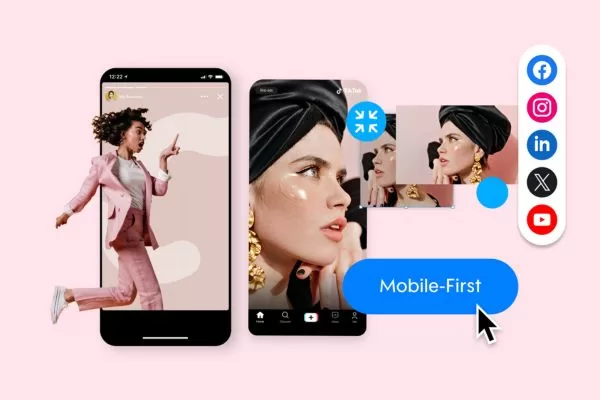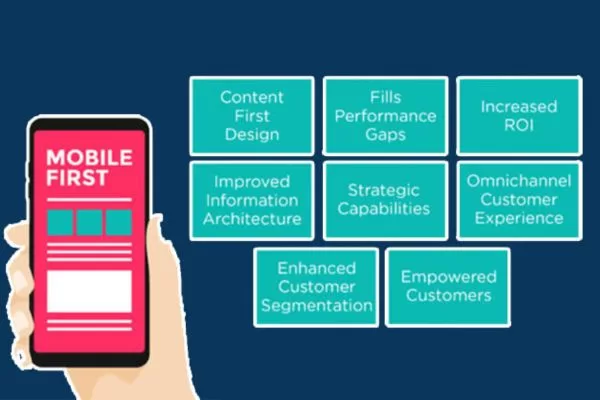Insights
Mobile First Marketing: Intelligent Strategy For The Digital Age!
On Digitals
26/11/2025
39
Mobile first marketing is essential to online success, as 80% of people use their phones to browse the internet, and nearly two-thirds experience nomophobia, reflecting how indispensable smartphones have become in daily life. Let’s embrace this strategy to maximize your digital impact!
What does mobile first mean?
Mobile first marketing refers to planning strategies and platforms with a focus on mobile users. Smartphones have grown even more ingrained in our daily lives due to their incredible development in everything from email to picture and browsing to paying.
You should consider web design and the user experience of mobile websites in light of this. This translates to a simple reading and scrolling experience for mobile phone users. Include clickable phone numbers that allow users to call, scan, pay, or send emails instantly.
With 5 billion smartphone owners worldwide (Statista), mobile devices give us access to countless tools, and this usage keeps growing. In the UK, 60% browse the internet and 50% of emails are opened via mobile, while 75% of LinkedIn traffic and 27% of global voice searches happen on smartphones (Hootsuite, Google). Clearly, mobile first behavior is reshaping how we interact with digital content.
Using mobile first approach entails creating content that is enjoyable to use on a mobile device. Additionally, as most users see mobile phone information in portrait orientation, this will require considering portrait views rather than landscape views. You may lower your bounce rates and enhance the average time people spend on your website by creating a responsive, smartphone-friendly design. And that’s what you want.

Basic information about mobile first marketing
The impact of mobile first marketing on modern user experience
These days, more individuals use cellphones than desktop computers to access the internet. Users are likely to abandon a slow, difficult-to-use, or poorly displayed website in favor of a competitor’s site. Additionally, mobile-friendly websites are ranked higher by search engines like Google.
Accordingly, a mobile first marketing strategy can increase a company’s online presence and attract more clients. Similarly, a website optimized for mobile devices provides an improved user experience (UX). It offers straightforward navigation, loads swiftly, and is easy to read.
Mobile first marketing enhances user experience by designing websites for small screens, simplifying navigation, optimizing images for faster loading, and using larger, tap-friendly buttons. Longer visit durations and improved conversion rates are the results of a satisfying user experience. Users are more likely to visit a website again and refer others to it if they find it easy to use on their mobile devices.
Furthermore, mobile first design frequently results in simpler, cleaner layouts that remove extraneous clutter. Whether it’s a product description, blog article, or contact details, this simplicity helps users concentrate on the stuff that really counts. Businesses may increase loyalty and promote return visits by putting the customer experience first, both of which are essential for long-term success.

Mobile first marketing improves modern users’ overall experience
Mobile first marketing’s advantages
For companies looking to prosper in the digital world, adopting a mobile first strategy can have a number of benefits. Businesses may increase customer interaction, reach a wider audience, and ultimately succeed online by implementing key mobile first principles.
A smart mobile first approach can have a number of advantages, for example:
- Increased traffic: A website that is optimized for mobile devices will draw more users and appear higher in search results.
- Improved conversion rates: A satisfying mobile experience entices users to remain longer, peruse your products, and eventually become clients.
- Better brand image: Showing that you are concerned about the mobile experience demonstrates that you are a cutting-edge, customer-focused company.
- Competitive advantage: Having a mobile-friendly website is crucial for remaining competitive as more companies implement mobile first tactics.

Mobile first marketing provides many benefits for businesses
Essential components of a mobile marketing plan
You must concentrate on how your digital presence functions on phones in order to develop a strong mobile marketing strategy. It goes beyond simply making things smaller to fit on a smaller screen. Your mobile digital strategy should be designed with quick access, simple interaction, and seamless navigation in mind. The following are the main elements to concentrate on:
Designing responsive websites
Any screen size should be automatically accommodated by your website. Users won’t need to squeeze, zoom, or scroll sideways thanks to a responsive site design. The basis of mobile first marketing is this. Because search engines give preferences to mobile-friendly websites, it also improves search ranks.
Quick loading times
When it comes to retaining mobile customers on your website, speed is crucial. Most users won’t wait if a page takes longer than a few seconds to load. Faster load speeds should be the main goal of your mobile marketing strategy. To achieve this, use mobile first design, minimize bulky scripts, and compress images. Frequent performance testing ensures that everything functions properly, particularly on smaller displays.
CTAs that are clear and clickable
Buttons on mobile devices must be simple to press. You shouldn’t have to scroll too far to see your call to action. Make sure links are compatible with all devices and avoid putting them too close to one another.
Mobile first content approach
Mobile content should be concise and easy to read, with legible fonts, clear headers, and bullet points where appropriate. Graphics and videos should load fast and display properly. This strategy is quite beneficial for e-commerce mobile marketing. Conversion rates can be raised with a clear product image, a succinct description, and an easy checkout procedure.
Push notifications and SMS
Customers can be reached directly through text messaging and mobile alerts. They might remind consumers about abandoned carts, advertise special discounts, or increase traffic to your website. These solutions are particularly helpful for small businesses with time-sensitive or local deals when it comes to mobile first marketing.
Mobile local SEO
Being visible in local searches is essential for service-oriented businesses. Make sure your address and contact information are easily accessible, employ location-specific keywords, and keep your Google Business Profile up to date. For new businesses aiming to attract local clients, this facilitates mobile first marketing.
Every component of your mobile marketing plan ought to complement the others. Your content is easier to read on a fast website. Users are motivated to act by compelling content. Additionally, resources like local search and SMS aid in attracting new customers.

Mobile marketing strategy needs optimized design and content
Avoid these errors in mobile first marketing
Your mobile marketing strategy’s effectiveness can be impacted by even minor errors. Failing to test your website on many devices is a regular problem. Users will rapidly quit your pages if they don’t load quickly or appear tidy on mobile devices. This is particularly crucial for e-commerce mobile marketing since layout and speed have a direct bearing on sales.
Neglecting local optimization is another mistake. Local search presence is crucial for small business mobile marketing. Potential clients might not find you if your Google Business Profile is missing or out-of-date. This information might let you stand out in a crowded industry when it comes to mobile marketing for new company pages.
Additionally, many companies attempt to repurpose desktop material for mobile devices, which can result in confusing layouts, tiny fonts, and crowded designs. Short paragraphs, larger fonts, and tap-friendly buttons that facilitate a clear path to conversion are all important components of a mobile first content strategy.
Crucial mobile first marketing techniques
Brands must go beyond basic mobile compatibility and develop their strategies with a mobile first attitude in order to thrive in today’s mobile-dominated environment.
Adapt your website for mobile users
Search engine optimization (SEO) tactics must explicitly target mobile consumers since mobile devices account for the majority of search traffic.
- Concentrate on Local SEO: Since a lot of mobile searches are location-based, local SEO is essential to mobile first marketing. Make sure your address, phone number, and hours are current and that your company is listed on Google My Business.
- Use voice search: More people are using voice searches, especially on mobile devices. To increase voice search traffic, optimize content for conversational keywords and question-based queries.
- Prioritize quick load times: This is a priority because mobile users quickly leave pages that take a long time to load. Utilize tools like Google’s Pagespeed Insights to evaluate and enhance load times by utilizing browser caching, reducing code, and compressing pictures.
Create content that is mobile-responsive
Mobile-friendly content will increase user engagement and enhance site performance.
- Make use of scannable paragraphs: It might be difficult to comprehend lengthy text blocks on small devices. For ease of browsing, divide the text into manageable chunks with distinct subheadings.
- Produce visual content: Infographics, movies, and pictures are examples of visual material that is especially effective on mobile devices. To make content more interesting, think about using interactive features like tapping or swiping.
- Modify CTA buttons for touch: Call-to-action (CTA) buttons that are mobile-friendly should be big, easy to see, and simple to tap. CTAs can also be made more accessible by positioning them close to the bottom or center of the screen.
Boost formats for mobile first advertising
Mobile advertising provides distinctive formats and places to draw people in and encourage interaction. Here are some mobile ad formats that work well:
- In-app ads: Since most mobile time is spent in applications, in-app advertisements are a great way to connect with mobile users. Social media sites like Facebook, Instagram, and Tiktok provide non-instructive in-feed advertisements that blend in with the content.
- Location-based ads: To display advertisements to consumers in a particular region, utilize geotargeting. Use location-based advertisements, for instance, to reach nearby potential clients and increase foot traffic if you run a local shop.
- Interactive ads: Playable advertisements in mobile games are examples of interactive ads that let consumers interact directly with your business. These advertisements boost brand recall and offer a memorable experience.
Make email campaigns that are mobile-friendly
One of the best digital marketing channels is still email, and increasing open rates and click-throughs requires mobile email optimization.
- Employ responsive email design: These emails are easier to read on mobile devices since they instantly adapt to match any screen size. Mobile-friendly layouts are available on sites like Constant Contact and Mailchimp.
- Keep subject line brief: Because mobile screens display fewer characters, make sure your subject lines are succinct and direct. To ensure readability, try to keep subject lines around 40 characters.
- Use a single-column layout: A single-column layout keeps the message simple and makes it easier to read on small displays. To promote clicks, use big buttons and succinct calls to action.
Use mobile content on social media
Developing content especially for mobile users will increase reach and engagement because mobile devices account for the majority of social media participation.
- Create vertical videos: On mobile devices, vertical videos take up the entire screen and create a more engaging experience. Vertical video content works well on platforms like Youtube shorts, Tiktok, and Instagram Stories.
- Accept short-form content: Bite-sized, portable content is preferred by mobile consumers. Write succinct, powerful pieces with captivating images and succinct captions.
- Incorporate interactive elements: By encouraging viewers to connect with your content, polls, quizzes, and interactive stickers on platforms like Instagram Stories can increase visibility and engagement.
Give mobile UX top priority on the website
Retaining visitors and enticing them to continue exploring your website depend heavily on an intuitive mobile user experience.
- Use thumb-friendly navigation: Make sure that clickable components and navigation menus are easily accessible with one hand. Steer clear of packing the screen with tiny symbols or links.
- Optimize forms for mobile: Completing lengthy forms on a mobile device can be difficult. Forms can be made simpler by eliminating fields that aren’t needed, utilizing auto-fill when it’s feasible, and segmenting long forms into sections.
- Leverage Accelerated Mobile Pages (AMP): AMP technology facilitates faster and more seamless page loads on mobile devices. For websites with a lot of content, like blogs or news sites, AMP is very helpful.

Apply effective mobile first techniques for business success
How to measure the success of mobile first marketing strategies
Use these KPIs to track and assess your efforts on a regular basis to make sure your mobile first marketing initiatives are working:
- Mobile traffic and engagement: To gauge engagement, monitor mobile traffic, bounce rates, and session length using tools like Google Analytics.
- Conversion rate on mobile devices: To assess how well your mobile user experience is working, track mobile conversion rates for actions like purchases, sign-ups, or contact form submissions.
- Mobile SEO performance: Monitor organic search traffic and mobile keyword ranks to determine how visible you are in mobile search marketing results.
- Social media engagement on mobile: Keep an eye on your posts, advertisements, and video content’s mobile engagement rates to gauge their efficacy, as the majority of social media consumers utilize mobile devices.
Mobile first marketing across the digital ecosystem
Mobile first marketing ensures every digital touchpoint is designed for the way people truly browse, interact, and make decisions on mobile devices. By aligning content, UX, and engagement strategies around mobile behavior, brands can create seamless experiences that perform consistently across the entire digital ecosystem.
Mobile-First SEO
In today’s search landscape, mobile-first optimization is no longer optional – it is the foundation of sustainable visibility. These strategies ensure your website performs flawlessly on mobile devices while meeting modern search engine expectations.
Responsive technical structure
A responsive technical structure ensures your website adapts seamlessly to every screen size. It reduces layout shifts, improves load times, and enhances crawlability across devices. Search engines prioritize mobile-ready pages, rewarding them with higher rankings. A solid structure also prevents usability issues that frustrate mobile users.
A well-engineered framework enhances both performance and consistency. It helps search bots understand your content more efficiently, boosting indexation quality. Mobile visitors experience smoother transitions across pages, improving retention. Ultimately, a responsive structure becomes the backbone of long-term SEO success.
Present content in a mobile-optimized format
Content crafted for mobile improves readability and user engagement. Shorter paragraphs, scannable sections, and clean formatting help users absorb information quickly. Search engines recognize this kind of content as more relevant to mobile users. As a result, your visibility and click-through rates naturally improve.
Content optimized for mobile also encourages longer dwell times, a key metric for user engagement. Clear messaging and intuitive design keep users engaged longer. With fewer distractions on mobile screens, every sentence must be concise and purposeful. This approach strengthens both user satisfaction and algorithmic performance.
Speed – Core web vitals
Page speed is one of the strongest predictors of mobile success. Faster websites keep users engaged and reduce abandonment rates. Search engines also use speed as a critical ranking factor, especially on mobile queries. Meeting Core Web Vitals benchmarks positions your site as technically superior.
Optimizing speed requires improvements in hosting, caching, and media compression. Each enhancement contributes to a smoother mobile browsing experience. Users quickly notice and appreciate fast-loading pages, especially on slower connections. These improvements build trust and encourage more interactions across your site.
Mobile first social media
A mobile-first approach to social platforms helps brands connect more naturally with their audiences. These strategies focus on speed, clarity, and engagement tailored for small screens and fast-paced interactions.
Design content prioritizing vertical display
Vertical formats dominate mobile platforms because they match the way users naturally hold their devices. Designing content in this layout ensures maximum visibility and engagement. Videos and images feel more immersive when optimized for vertical display. This approach aligns perfectly with the consumption habits of modern users.
Creating vertical-first assets also enhances storytelling flexibility. Social platforms increasingly prioritize vertical content in their algorithms. Brands that embrace this trend gain more organic reach and interaction. It becomes a strategic advantage across all major mobile-driven networks.
Mobile-native engagement techniques
Mobile-native techniques streamline interactions and encourage quick responses. Tap-friendly elements, short captions, and bold visuals perform best on small screens. Users appreciate content they can engage with effortlessly. This behavior boosts platform signals and improves overall reach.
Polls, stickers, and interactive stories thrive in mobile environments. These features encourage participation and foster stronger brand connections. They supply insights that reflect audience interests. As engagement rises, your visibility and community impact follow suit.
Real-time micro content
Micro content fits perfectly into the fast-paced nature of mobile browsing. Short videos, quick tips, and snackable visuals capture immediate attention. Users consume them rapidly, often sharing them with friends. This helps brands spread their message more efficiently.
Real-time content brings an additional layer of relevance. Posting during trending moments boosts both visibility and engagement. Mobile users respond quickly to timely updates that resonate with current events. This agile approach keeps your brand dynamic and culturally connected.
Mobile-first web design & UX
A mobile-first design philosophy ensures every touchpoint is intentionally crafted for small screens. These principles create a smooth, intuitive experience that boosts retention, credibility, and conversions.
Build an interface that’s easy to use by touch
Touch-friendly design helps users navigate effortlessly on mobile devices. Large tap areas reduce misclicks and frustration. Clean spacing keeps the layout breathable and easy to understand. This structure promotes smooth interaction across every screen.
A touch-optimized interface also boosts conversion rates. Users feel more confident completing actions without zooming or adjusting. The simplicity reinforces trust and satisfaction. Over time, this increases return visits and long-term loyalty.
Streamlined mobile navigation
Mobile navigation must be simple, intuitive, and fast. Users expect to reach key information within a few taps. Minimalist menus help reduce cognitive overload. These elements create a seamless path through your site.
Streamlined navigation also improves search visibility. Engines favor sites with strong mobile usability metrics. Good navigation lowers bounce rates and increases session depth. This combination strengthens your overall digital presence.
Minimalist visual hierarchy
Minimalist design guides users through a clear, uncluttered experience. Strategic spacing and contrast help highlight what matters most. Mobile screens benefit greatly from simplicity and clarity. This technique strengthens both visual design and functionality.
A strong visual hierarchy reduces confusion and increases engagement. Users intuitively follow the flow of well-organized content. Designers can emphasize calls-to-action more effectively. The result is a mobile experience that feels focused and effortless.

Mobile first marketing connects effectively across digital ecosystems
Conclusion
Mobile first marketing is no longer optional – it’s essential for brands aiming to reach today’s always-connected consumers. By delivering mobile-friendly content, ads, and user experiences, businesses can improve accessibility, engagement, and conversions. As mobile usage continues to dominate online behavior, only brands that prioritize mobile-first strategies will stay competitive. Boost your mobile-first marketing results and stay ahead of the competition with On Digitals expert support.
NEWEST POSTS
- A Complete Guide to Programmatic Advertising for Digital Campaign Success
- A Complete Guide to Influencer Marketing ROI for Better Performance
- Account Based Marketing For B2B Teams Seeking Stronger Growth
- How To Spot Fake Followers On Influencer Profiles And Boost ROI
- Nano Vs micro influencers: Key differences And Best Uses
Read more
